| Part of the Politics series |
| Voting |
|---|
|
|
A ballot box is a temporarily sealed container, usually a square box though sometimes a tamper resistant bag, with a narrow slot in the top sufficient to accept a ballot paper in an election but which prevents anyone from accessing the votes cast until the close of the voting period. A ballot drop box allows voters who have received a ballot by mail to submit it for counting in a self-service fashion.
Usage
It will usually be located in a polling station although in some countries, notably Ireland, Italy and Russia, there may also be ballot boxes that are taken to people's homes where they would otherwise be unable to travel to the polling station. When very large ballot papers are used, there may be a feeder mechanism to assist in the deposit of the paper into the box.
Transparent ballot boxes may be used in order for people to be able to witness that the box is empty prior to the start of the election (i.e. not stuffed with fraudulent votes).
At the close of the election all boxes can be taken to a single location for tallying (the count) and the result declared. Alternately the boxes can be tallied at the polling station, with individual stations announcing their results to be tallied (known as precinct count).
Ballot boxes are obsolete in some jurisdictions because of the increase in paperless electronic voting.
The word ballot derives from voting systems based upon the use of a small ball instead of a voting paper: see blackball.
History
In the Roman Republic, each voter initially gave his vote orally to an official who made a note of it on an official tablet, but later in the Republic, the secret ballot was introduced, and the voter recorded his vote with a stylus on a wax-covered boxwood tablet, then dropped the completed ballot in the sitella or urna (voting urn), sometimes also called cista.[1]
The first British secret ballot using ballot papers and a ballot box was held in Pontefract on 15 August 1872, under the terms of the recently enacted Ballot Act 1872. In a ministerial by-election following his appointment as Chancellor of the Duchy of Lancaster, Hugh Childers was re-elected as MP for Pontefract. The original ballot box, sealed in wax with a liquorice stamp, is held at Pontefract Museum.[2][3]
Photo gallery
 A cardboard ballot box used during the first federal vote in Washington, D.C.
A cardboard ballot box used during the first federal vote in Washington, D.C.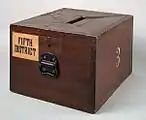 A wooden ballot box used in the northeastern United States c. 1870
A wooden ballot box used in the northeastern United States c. 1870 A galvanized metal ballot box used in Tulare County, California, United States, c. 1936
A galvanized metal ballot box used in Tulare County, California, United States, c. 1936 A voter putting her envelope into a clear ballot box during the 2007 French presidential election
A voter putting her envelope into a clear ballot box during the 2007 French presidential election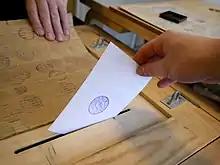 Ballot being dropped into a ballot box during the 2018 Finnish presidential election
Ballot being dropped into a ballot box during the 2018 Finnish presidential election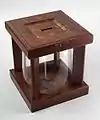 A glass globe ballot jar c. 1884
A glass globe ballot jar c. 1884 An Acme voting machine of Bridgewater, Connecticut, c. 1880
An Acme voting machine of Bridgewater, Connecticut, c. 1880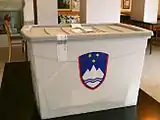 A translucent ballot box (Tiobox) used in Slovenia
A translucent ballot box (Tiobox) used in Slovenia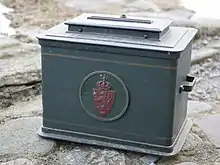 An old metal ballot box used in Norway
An old metal ballot box used in Norway A ballot box at the start of the controversial 2014 Crimean referendum
A ballot box at the start of the controversial 2014 Crimean referendum A man in Sarakhs put his vote to ballot, 2013 Iranian presidential election.
A man in Sarakhs put his vote to ballot, 2013 Iranian presidential election..jpg.webp) Secured ballot boxes in the Democratic Republic of the Congo
Secured ballot boxes in the Democratic Republic of the Congo Ballot boxes used in the Philippines before automation was implemented on 2008 Autonomous Region in Muslim Mindanao regional elections on 11 August 2008
Ballot boxes used in the Philippines before automation was implemented on 2008 Autonomous Region in Muslim Mindanao regional elections on 11 August 2008.jpg.webp) A recycling bin as ballot box for the 2017 German federal election; Central Electoral Office of the City of Bochum
A recycling bin as ballot box for the 2017 German federal election; Central Electoral Office of the City of Bochum Ballot boxes in Ukraine, which are transparent to prevent pre-stuffing the box with fake ballots
Ballot boxes in Ukraine, which are transparent to prevent pre-stuffing the box with fake ballots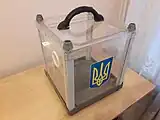 Small (mobile) ballot box in Ukraine, for voting outside of polling station by people who are unable to come to the polling station by themself
Small (mobile) ballot box in Ukraine, for voting outside of polling station by people who are unable to come to the polling station by themself
See also
References
- ↑ The Oxford Companion to Classical Civilization (eds. Simon Hornblower, Antony Spawforth, Esther Eidinow: Oxford University Press, 2014), p. 267.
- ↑ Pontefract's secret ballot box, 1872 Archived 2019-12-16 at the Wayback Machine.
- ↑ "Wakefield Metropolitan District Council website". Archived from the original on 2007-09-27. Retrieved 2007-05-06.
External links
 Media related to Ballot boxes at Wikimedia Commons
Media related to Ballot boxes at Wikimedia Commons